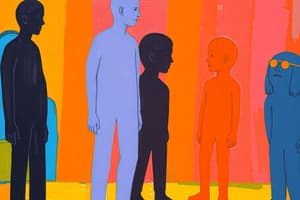Podcast
Questions and Answers
What is the primary argument of Allport regarding group behavior?
What is the primary argument of Allport regarding group behavior?
- Group behavior can be explained through environmental stimuli alone.
- Understanding individual psychology is key to understanding group dynamics. (correct)
- Individuals behave uniformly in group settings regardless of stimuli.
- Group behavior is solely dependent on the presence of social norms.
What does Sherif's study primarily illustrate about group norms?
What does Sherif's study primarily illustrate about group norms?
- Group norms are entirely independent from individual judgments.
- Group norms can emerge and develop through social interaction. (correct)
- Norms exist only before individuals interact with one another.
- Individual responses are unchangeable once formed.
How did participants' judgments about the moving light differ in Sherif's two phases?
How did participants' judgments about the moving light differ in Sherif's two phases?
- Judgments remained unchanged when seen in groups first.
- Individuals conformed more in the group phase after individual judgments. (correct)
- Participants were inconsistent in both phases regardless of their condition.
- There was no significant difference in judgments regardless of the condition.
What is a key limitation of Allport's approach to understanding group behavior?
What is a key limitation of Allport's approach to understanding group behavior?
What is described as a socially shared guideline for behavior?
What is described as a socially shared guideline for behavior?
What does the term 'internalised' refer to in the context of group norms?
What does the term 'internalised' refer to in the context of group norms?
What was the primary goal of Asch's line judgment task?
What was the primary goal of Asch's line judgment task?
What was the overall error rate observed in Asch's study?
What was the overall error rate observed in Asch's study?
Which of the following concepts is emphasized by Deutsch and Gerrard's dual process theory?
Which of the following concepts is emphasized by Deutsch and Gerrard's dual process theory?
In contemporary research, what effect does agreement with fellow group members have on an individual's confidence?
In contemporary research, what effect does agreement with fellow group members have on an individual's confidence?
What was a finding from Platow et al's 2005 comedy study regarding laughter?
What was a finding from Platow et al's 2005 comedy study regarding laughter?
What impact did reassurance from a fellow group member have in Platow et al's icy water experiment?
What impact did reassurance from a fellow group member have in Platow et al's icy water experiment?
The term 'referent informational influence' is related to which aspect of group dynamics?
The term 'referent informational influence' is related to which aspect of group dynamics?
What did the study involving science students and icy water measure?
What did the study involving science students and icy water measure?
Which result reflects the effectiveness of group norms persisting after group membership changes?
Which result reflects the effectiveness of group norms persisting after group membership changes?
Flashcards
Allport's view on social psychology
Allport's view on social psychology
Social psychology is just individual psychology applied to social situations. Social behavior is determined by individual attributes and responses to environmental stimuli; group processes aren't a unique phenomenon.
Social norm
Social norm
Shared, socially prescribed ways of understanding and acting in the world. They guide behavior and dictate how we ought to act.
Sherif's Autokinetic Effect Study
Sherif's Autokinetic Effect Study
A study in which participants judged the movement of a stationary light in a dark room, used to understand how social norms emerge from group interactions.
Group norm emergence
Group norm emergence
Signup and view all the flashcards
Social Influence
Social Influence
Signup and view all the flashcards
Conformity
Conformity
Signup and view all the flashcards
Group Norm
Group Norm
Signup and view all the flashcards
Informational Influence
Informational Influence
Signup and view all the flashcards
Normative Influence
Normative Influence
Signup and view all the flashcards
Asch's Experiment
Asch's Experiment
Signup and view all the flashcards
Sherif's Experiment
Sherif's Experiment
Signup and view all the flashcards
Reassurance effect.
Reassurance effect.
Signup and view all the flashcards
In-group/out-group
In-group/out-group
Signup and view all the flashcards
Referent informational influence
Referent informational influence
Signup and view all the flashcards
Conformity rates
Conformity rates
Signup and view all the flashcards
Study Notes
Classic Studies on Social Influence
- Allport (1924): Argued social psychology is just individual psychology applied to social situations. Focuses on individual attributes and responses, which then become stimuli for others. Ignored the role of social norms.
Sherif (1935): Norm Formation
- Autokinetic Effect Study: Participants judged the apparent movement of a stationary light.
- Two Conditions:
- Alone then in groups: Individual norms initially, then converged on a group norm.
- In groups then alone: Group norm persisted even when judgments were made alone.
- Conclusions: Judgments reflect conformity to a group norm, created through interaction and information sharing. This norm becomes internalized and guides future judgments, even without the group present.
Asch (1951): Conformity
- Line Judgment Task: Participants judged line lengths. Stooges gave incorrect answers, and the study measured how often participants conformed.
- Results: Shows strong conformity despite obvious correct answers. A significant portion of participants gave incorrect answers to conform.
Deutsch and Gerrard (1955): Dual Process Theory
- Integration of Sherif and Asch's Findings: Proposed two types of social influence:
- Informational influence: (Sherif) influenced by others' judgments.
- Normative influence: (Asch) influenced by expectations to conform.
Contemporary Research: Referent Informational Influence
-
Turner (1991): Emphasized the role of group memberships in self-definition. Trust and agreement with fellow group members impacts judgment.
-
Platow et al (2005): Experiment using comedy and laughter judgments. Participants' laughter and smiles increased for laughter of fellow group members compared to out-group members. Group membership influences how others impact our own behaviour. Laughter and smiling behaviour is influenced by in-group or out-of-group perception.
-
Platow et al (2005): Science students completing a task (icy water). Findings indicated that reassurance/support from a fellow group member was impactful and decreased anxiety for the task. The result demonstrated that group identification reduces anxiety.
Studying That Suits You
Use AI to generate personalized quizzes and flashcards to suit your learning preferences.





